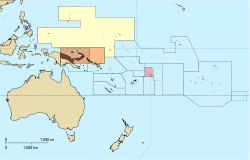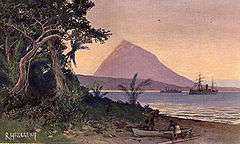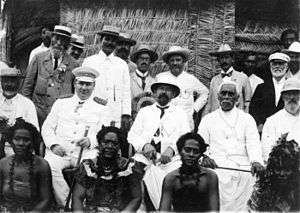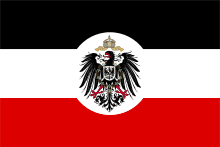German Samoa
| German Samoa | ||||||||||
| Deutsch-Samoa | ||||||||||
| German colony | ||||||||||
| ||||||||||
| ||||||||||
 Brown = German New Guinea; Yellow = German Pacific Protectorates; Red = German Samoa; Orange = North Solomons, ceded to Britain | ||||||||||
| Capital | Apia | |||||||||
| Languages | German (official), Samoan | |||||||||
| Political structure | Colony | |||||||||
| Head of State | Kaiser Wilhelm II | |||||||||
| Gouvenor: Wilhelm Solf | ||||||||||
| highest Chief: Mata'afa | ||||||||||
| Historical era | German colonization in the Pacific Ocean | |||||||||
| • | Tripartite Convention | 2 December 1899 | ||||||||
| • | Colonization | 1 March 1900 | ||||||||
| • | NZ occupation | 30 August 1914 | ||||||||
| • | Treaty of Versailles | 10 January 1920 | ||||||||
| • | League mandate | 17 December 1920 | ||||||||
| Currency | Goldmark | |||||||||
| ||||||||||
German Samoa (German: Deutsch-Samoa) was a German protectorate from 1900 to 1914, consisting of the islands of Upolu, Savai'i, Apolima and Manono, now wholly within the independent state Samoa, formerly Western Samoa. Samoa was the last German colonial acquisition in the Pacific basin, received following the Tripartite Convention signed at Washington on 2 December 1899 with ratifications exchanged on 16 February 1900.[1][2] It was the only German colony in the Pacific, aside from the Kiautschou concession in China, that was administered separately from German New Guinea.
Expansion of German influence
In 1855 J.C. Godeffroy & Sohn expanded its trading business into the Pacific following negotiations by August Unshelm, Godeffroy’s agent in Valparaiso. He sailed out to the Samoan Islands, which were then known as the Navigator Islands. During the second half of the 19th century German influence in Samoa expanded with large scale plantation operations being introduced for coconut, cacao and hevea rubber cultivation, especially on the island of 'Upolu where German firms monopolized copra and cocoa bean processing.
The trading operations of J.C. Godeffroy & Sohn extending to islands in the Central Pacific.[3] In 1865 a trading captain acting on behalf of J.C. Godeffroy & Sohn obtained a 25-year lease to the eastern islet of Niuoku of Nukulaelae Atoll.[4] J. C. Godeffroy und Sohn was in 1879 taken over by Handels-und Plantagen-Gesellschaft der Südsee-Inseln zu Hamburg (DHPG). Competition in the trading operations in the Central Pacific came from Ruge, Hedemann & Co, established in 1875,[3] which was succeeded by H. M. Ruge and Company until that firm failed in about 1887.[5]
Tensions caused in part by the conflicting interests of the German traders and plantation owners and British business enterprises and American business interests led to the first Samoan Civil War. The war was fought roughly between 1886 and 1894, primarily between Samoans though the German military intervened on several occasions. The United States and the United Kingdom opposed the German activity which led to a confrontation in Apia Harbor in 1887.[6]
In 1899 after the Second Samoan Civil War the Samoan Islands were divided by the three involved powers. The Samoa Tripartite Convention gave control of the islands west of 171 degrees west longitude to Germany, the eastern islands to the United States (present-day American Samoa) and the United Kingdom was compensated with other territories in the Pacific and West Africa.[1]
Economic development

During the colonial years new companies were formed to greatly expand agricultural activities which in turn increased tax revenues for public works that further stimulated economic growth; “... over all, the period of German rule was the most progressive, economically, that the country has experienced.”[7] J. C. Godeffroy, as the leading trading and plantation company on Samoa, maintained communications among its various subdivisions and branches and the home base at Hamburg with its own fleet of ships.[8] Since the Samoan cultural envelope did not include “labor for hire,” the importation of Chinese (coolie) laborers (and to a lesser extent Melanesians from New Guinea working for DHPG) was implemented,[9] and “ ... by 1914 over 2,000 Chinese were in the colony, providing an effective labor force for the [German] plantations.”[10]
Major plantation enterprises on Samoa:
- J. C. Godeffroy & Son (superseded as Deutsche Handels und Plantagen Gesellschaft or DHPG)
- Deutsche Samoa Gesellschaft
- Safata-Samoa-Gesellschaft
- Samoa Kautschuk Kompagnie
Colonial administration



The German colonial period lasted for 14 years and officially began with the raising of the imperial flag on 1 March 1900. Wilhelm Solf became the first governor. In its political relations with the Samoan people, Solf’s government showed similar qualities of intelligence and care as in the economic arena.[11] He skillfully grafted Samoan institutions into the new system of colonial government by the acceptance of native customs.[12] Solf himself learned many of the customs and rituals important to the Samoan people, observing cultural etiquette including the ceremonial drinking of kava.[13]
However, when a dissident Samoan matai (chief) exceeded the limits of his considerable tolerance, Solf stepped in assertively, pronouncing that “... there was only one government in Samoa,” and it was him.[14] “German rule brought peace and order for the first time ... Authority, in the person of the governor, became paternal, fair, and absolute. Berlin was far away; there was no cable or radio.”[15] Energetic efforts by colonial administrators established the first public school system; a hospital was built and staffed and enlarged as needed, and Samoan women were trained as nurses.
Of all colonial possessions of the European powers in the Pacific, German Samoa was by far the best-roaded;[16] all roads up until 1942 had been constructed under German direction. The imperial grants from the Berlin treasury which had marked the first eight years of German rule were no longer needed after 1908. Samoa had become a self-supporting colony.[17] Wilhelm Solf left Samoa in 1910 to be appointed Colonial Secretary at Berlin; he was succeeded as governor by Erich Schultz, the former chief justice in the protectorate.
Occupation of German Samoa

Other than native Samoan police, Germany had no armed forces stationed in the islands. The small gunboat SMS Geier and the unarmed survey ship Planet were assigned to the so-called "Australian Station" (encompassing all German South Seas protectorates, not the British dominion Australia), but Geier never reached Samoa.[18]
At the behest of Great Britain the colony was invaded unopposed on the morning of 29 August 1914 by troops of the New Zealand Expeditionary Force. Vice Admiral Count Maximilian von Spee of the German East Asia Squadron gained knowledge of the occupation and hastened to Samoa with the armored cruisers SMS Scharnhorst and SMS Gneisenau, arriving off Apia on 14 September 1914. However, he determined that a landing would only be of temporary advantage in an Allied dominated sea and the cruisers departed.[19] New Zealand occupied the German colony through to 1920, then governed the islands until independence in 1962 as a (1) League of Nations Class C Mandate[20] and (2) United Nations Trust Territory after 1946.
See also
References

- 1 2 Ryden, George Herbert. The Foreign Policy of the United States in Relation to Samoa. New York: Octagon Books, 1975. (Reprint by special arrangement with Yale University Press. Originally published at New Haven: Yale University Press, 1928), p. 574; the Tripartite Convention (United States, Germany, Great Britain) was signed at Washington on 2 December 1899 with ratifications exchanged on 16 February 1900
- ↑ Flag raising at Mulinu'u Point was 1 March 1900
- 1 2 Masterman, Sylvia (1934). "The Origins of International Rivalry in Samoa: 1845–1884, Chapter ii. The Godeffroy Firm". George Allen and Unwin Ltd, London NZETC. p. 63. Retrieved 15 April 2013.
- ↑ Suamalie N.T. Iosefa; Doug Munro; Niko Besnier (1991). Tala O Niuoku, Te: the German Plantation on Nukulaelae Atoll 1865-1890. Published by the Institute of Pacific Studies. ISBN 9820200733.
- ↑ "The 'Ownership' of Niulakita, 1880-1896". Tuvalu: A History. Institute of Pacific Studies, University of the South Pacific and Government of Tuvalu. 1983. pp. 196–197.
|first1=missing|last1=in Authors list (help) - ↑ Stevenson, Robert Louis (1892). A Footnote to History: Eight Years of Trouble in Samoa. BiblioBazaar. ISBN 1-4264-0754-8.
- ↑ Davidson, Samoa mo Samoa, p. 82
- ↑ Washausen, Hamburg und die Kolonialpolitik des Deutschen Reiches, p. 56
- ↑ Spoehr, White Falcon, p. 40-42
- ↑ Davidson, p. 77
- ↑ Davidson, p. 78
- ↑ Lewthwaite, in Western Samoa, p. 130
- ↑ Rowe, Newton A (1930). Samoa Under the Sailing Gods. New Zealand Electronic Text Centre, Victoria University of Wellington. Putnam. p. 11. Retrieved 25 February 2010.
- ↑ Lewthwaite, p. 148
- ↑ McKay, Samoana, p. 18
- ↑ Lewthwaite, p. 153
- ↑ Schultz-Naumann, Unter Kaisers Flagge, p. 163, the only other German protectorate in this category was Togoland
- ↑ At the outbreak of World War I, the gunboat was in transit from German East Africa to German New Guinea and met the light cruiser SMS Emden. Geier initially stayed on station in the German Caroline Islands, but the 20-year-old 'orphan' ship had no military value as a naval combatant and was short on coal and provisions. She proceeded in October 1914 to Honolulu in the United States Territory of Hawaii. Shadowed by the Japanese, she was interned. With United States entry into the war in April 1917, Geier was confiscated, renamed USS Schurz and operated by the United States Navy until 1918, when she sank after a collision mishap off the North Carolina coast.
- ↑ The ships inflicted some damage at Papeete, Tahiti and then rejoined the squadron en route to South America
- ↑ date of ratification by the League of Nations was 10 January 1920; Class C mandates were designed for populations considered incapable of self-government
Bibliography
- Davidson, J. W. Samoa mo Samoa [Samoa for the Samoans], The Emergence of the Independent State of Western Samoa. Melbourne: Oxford University Press. 1967. OCLC 222445762
- Deutsche Kolonialgesellschaft. Kleiner Deutscher Kolonialatlas. Berlin: Verlag Dietrich Reimer. 1899. OCLC 37420819
- Gerlach, Hans-Henning & Birken, Andreas. Die Südsee und die deutsche Seepost, deutsche Kolonien und deutsche Kolonialpolitik. Volume 4. Königsbronn. 2001. ISBN 3-931753-26-3 OCLC 49909546
- Graudenz, Karlheinz & Schindler, Hanns-Michael. Die deutschen Kolonien. Augsburg: Weltbildverlag. 1994. ISBN 3-89350-701-9
- Lewthwaite, Gordon R. “Life, Land and Agriculture to Mid-Century,” in Western Samoa. Edited by James W. Fox and Kenneth Brailey Cumberland. Christchurch, New Zealand: Whitcomb & Tombs Ltd. 1962. OCLC 512636
- McKay, Cyril Gilbert Reeves. Samoana, A Personal Story of the Samoan Islands. Wellington and Auckland: A.H. & A.W. Reed. 1968. OCLC 32790
- Schultz-Naumann, Joachim. Unter Kaisers Flagge, Deutschlands Schutzgebiete im Pazifik und in China einst und heute [Under the Kaiser’s Flag, Germany’s Protectorates in the Pacific and in China then and today]. Munich: Universitas Verlag. 1985. ISBN 3-8004-1094-X OCLC 14130501
- Ryden, George Herbert. The Foreign Policy of the United States in Relation to Samoa. New York: Octagon Books, 1975. (Reprint, originally published at New Haven: Yale University Press, 1928.) OCLC 185595285
- Spoehr, Florence Mann. White Falcon, The House of J.C. Godeffroy and its Commercial and Scientific Role in the Pacific. Palo Alto: Pacific Books. 1963. OCLC 3149438
- Washausen, Helmut. Hamburg und die Kolonialpolitik des Deutschen Reiches [Hamburg and Colonial Politics of the German Empire]. 1968. Hamburg: Hans Christians Verlag.
External links
- http://www.deutsche-schutzgebiete.de/deutsche-kolonien.htm (in German)
- Deutsches Koloniallexikon (in German)
Coordinates: 13°48′00″S 172°06′00″W / 13.8000°S 172.1000°W

